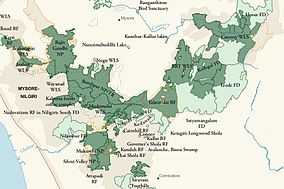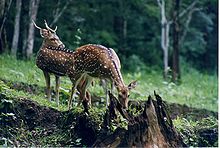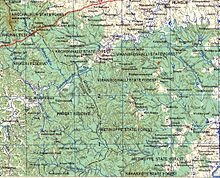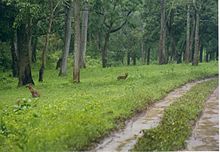- Nagarhole National Park
-
Nagarhole National Park IUCN Category II (National Park)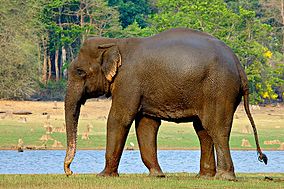
Elephant in musth at NagarholeMap of Nilgiris Biosphere Reserve, showing Nagarhole National Park (formerly Rajiv Gandhi National Park) in relation to multiple contiguous protected areas Location Kodagu (Coorg) District, India Nearest city Madikeri, India Coordinates 12°5′0″N 76°15′0″E / 12.083333°N 76.25°ECoordinates: 12°5′0″N 76°15′0″E / 12.083333°N 76.25°E Area 643 km2 (248 sq mi) Established 1988 Nagarhole National Park (Kannada: ನಾಗರಹೊಳೆ ರಾಷ್ಟೀಯ ಉದ್ಯಾನವನ), also known as "Rajiv Gandhi National Park", is located 94 kilometers (58 mi) from Mysore in Karnataka in South India. It is spread between Kodagu district and Mysore district. Located to the north-west of Bandipur National Park, Kabini reservoir separates the two. The park has rich forest cover, small streams, valleys, and waterfalls. The park has a healthy tiger-predator ratio, and tiger, Indian bison, and elephant are much more populous here than in Bandipur.
The park stretches over 643 square kilometres (248 sq mi),[1] protecting the wildlife of Karnataka. Together with the adjoining Bandipur National Park (870 km2 (340 sq mi)), Mudumalai National Park (320 km2 (120 sq mi)) and Wayanad Wildlife Sanctuary (344 km2 (133 sq mi)), it forms the largest protected area in Southern India, totalling 2,183 km2 (843 sq mi).
The park is part of the Nilgiri Biosphere Reserve. The Western Ghats, Nilgiri Sub-Cluster (6,000+ km²), including all of Nagarhole National Park, is under consideration by the UNESCO World Heritage Committee for selection as a World Heritage Site.[2]
Contents
History
The park was an exclusive hunting reserve of the former rulers of Mysore. This place derives its name from naga, meaning snake and hole, referring to streams. It was set up in 1955 as a wildlife sanctuary and later converted into a national park in year 1988.[1]
Terrain
The forest ranges the foothills of the Western Ghats spreading over to the hillside and south towards Kerala. The vegetation consists mainly of moist mixed deciduous forest (Tectona grandis, Dalbergia latifolia) in the southern parts, dry tropical forest (Wrightia tinctoria, Acacia) towards the east, and Sub mountain hill valley swamp forest (Eugenia).
Fauna and flora
The main trees found are Rosewood, Teak, Sandalwood and Silver oak. Species of trees of the dry deciduous forest include Terminalia tomentosa, Tectonia grandis, Lagerstroemia lanceolata,Pterocarpus marsupium, Grewia tilaefolia, Dalbergia latifolia and Anogeissus latifolia.[3] Other tree species that are seen in the forests are Lagerstroemia microcarpa, Adina cordifolia, Bombax malabaricum, Schleichera trijuga and species of Ficus. In the under storey, species found growing include Kydia calycina, Emblica officinalis and Gmelina arborea. Shrubs like Solanum, Desmodium, Helicteres species and invasive species like Lantana camara and Eupatorium too are found in abundance. The dry deciduous forests have many tree species commonly found in the moist deciduous forests like Anoegeissus latifolia, Cassia fistula, Butea monosperma, Dendrocalamus strictus, Wrightia tinctoria and Acacia sp., while the swamp forests have a predominance of Eugenia. In addition to Rosewood (Dalbergia latifolia) and Teak (Tectonia grandis) the other commercially important species of trees found in the forests include Sandalwood (Santalum album) and silver oak (Grevillea robusta)[4][5]
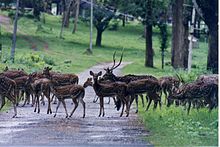 Chital herd, Nagarahole WLS, Kodagu District
Chital herd, Nagarahole WLS, Kodagu District
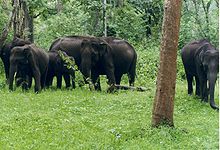 Elephant herd, Nagarahole WLS, Kodagu District
Elephant herd, Nagarahole WLS, Kodagu District
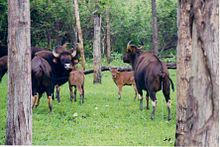 Gaur herd, Nagarahole WLS, Kodagu District
Gaur herd, Nagarahole WLS, Kodagu District
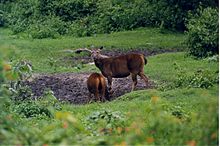 Sambar mother and fawn, Nagarahole WLS, Kodagu District
Sambar mother and fawn, Nagarahole WLS, Kodagu District
Flagship species like tiger (Panthera tigris), Indian bison or gaur (Bos gaurus) and Asian elephants (Elephas maximus) are found in large numbers inside the park. A study carried out by Dr. Ullas Karanth of the Wildlife Conservation Society has shown that the forests of Nagarhole have three species of predators i.e. tiger, leopard (Panthera pardus) and wild dogs (Cuon alpinus) present at an equivalent density (PA Update 2000). The park also has an abundance of jackals (Canis aureus), grey mongoose (Herpestes edwardsi), sloth bears (Melursus ursinus), striped hyenas (Hyaena hyaena), spotted deer or chital (Axis axis), sambar (Cervus unicolor), barking deer (Munitacus muntjak), four-horned antelopes (Tetracerpus quadricornis) and wild boar (Sus scrofa). Other mammalian inhabitants include the common palm civet (Paradoxurus hermaphroditus), brown mongoose (Herpestes brachyurus), striped-necked mongoose(Herpestes vitticollis), black-naped hare (Lepus nigricollis), mouse deer, Indian pangolin (Manis crassicaudata), red giant flying squirrel (Petaurista petaurista), Indian porcupine (Hystrix indica) and Indian giant flying squirrel (Petaurista philippensis).[4][5]
Recognised as an Important Bird Area the park has over 270 species of birds including the 'Critically endangered' Oriental white-backed vulture (Gyps bengalensis), 'Vulnerable' lesser adjutant (Leptopilos javanicus), greater spotted eagle (Aquila changa) and the Nilgiri wood-pigeon (Columba elphinstonii). 'Near threatened' species like darters (Anhniga melanogaster), oriental white ibis (Threskiornis melanocephalus), greater grey headed fish eagle (Icthyophaga ichthyaetus) and red headed vulture (Sarcogyps calvus) too can be found here. Endemics include the blue winged parakeet (Psittacula columboides), Malabar grey hornbill (Ocyceros griseus) and the white bellied treepie (Dendrocitta leucogastra). Seven of the 15 Biome-10 (Indian Peninsula Tropical Moist Forest) and 21 of the 59 Biome-11 (Indo-Malayan Tropical Dry Zone) species have been noted from here. Some of the birds that can be sighted here include the white cheeked barbet (Megalaima viridis), Indian scimitar babbler (Pomatorhinus horsfieldii) and Malabar whistling thrush (Myiophonus horsfieldii). Even birds commonly seen in drier regions like painted bush quail (Pendicula erythrorhyncha), Sirkeer malkhoa (Phaenicophaeus leschenaultia), ashy prinia (Prinia socialis), Indian robin (Saxicoloides fulicata), Indian peafowl (Pava cristatus) and yellow legged green pigeon (Treron phoenicoptera) can be found here.[4][5]
Reptiles commonly found here are common vine snake (Ahaetulla nasutus), common wolf snake (Lycodon aulicus), rat snake (Ptyas mucosus), bamboo pit viper (Trimeresurus gramineus), Russell's viper (Daboia russellii), common krait (Bangarus caeruleus), Indian rock python (Python molurus), Indian monitor lizard (Varanus bengalensis) and the common toad (Bufo melanostictus).[4][5]
Extensive studies on the biodiversity of the insect population have been carried out by researchers from the Ashoka Trust for Research in Ecology and the Environment, Bangalore. The insect biodiversity of this park includes over 96 species of dung beetles and 60 species of ants. Unusual species of ants that have been identified include the jumping ants such as Harpegnathos saltator, which are known to jump up to a metre high. The ant species Tetraponera rufonigra may be useful as a marker for the health of the forests because these ants feed on termites and are abundant in places where there are lots of dead trees. Species of dung beetles identified include the common dung beetle (Onthophagus dama), India's largest beetle, Heliocopris dominus which breeds only in elephant dung and Onthophagus pactolus, a very rare species of dung beetle.
Climate and ecology
Located in Kodagu district of Karnataka, with the Brahmagiri mountains forming a picturesque background, the Rajiv Gandhi National Park earlier known as the Nagarhole National Park was set up in 1955. The park forms a part of the Nilgiri Biosphere Reserve and has been nominated for selection as a World Heritage Site. It lies between the latitudes 12°15'37.69"E and longitudes 76°17'34.4"N. Altitude in the park varies from 687–960 m. By 1988 the protected area in this park was increased to occupy 643.39 km2. The park receives an annual rainfall of 1,440 mm and its water sources include the Lakshmmantirtha river, Sarati Hole, Nagar Hole, Balle Halla, Kabini river, four perennial streams, 47 seasonal streams, four small perennial lakes, 41 artificial tanks, several swamps, Taraka dam and the Kabini reservoir.[4]
Tribal and native inhabitants
The Jenu Kurubas, primary inhabitants of this forest area, are a tribe in Karnataka state and their traditional practices and rituals are slowly disappearing. The government is restricting their entry inside the National park and forest due to multiple factors including but not limited conservation efforts and bringing the community to the mainstream society.
The Ministry of Home Affairs, Government of India, identified the Jenu Kuruba and the Koraga are TRIBAL GROUPS in Karnataka. The Jenu Kurubas are traditional food gatherers and honey collectors. In Kannada, the term ‘Jenu’ means ‘honey’ and the term ‘kuruba’ generally mean ‘shepherd’. It is derived from the Kannada word ‘kuri’ which means ‘sheep’. The term kuruba is also associated with non-shepherd communities. They speak a variant form of Kannada commonly known as Jenu-nudi within their family kin group, and Kannada with others. They use Kannada script. According to the Census of 1981, the population of Jenu Kuruba community is 34,747 out of which 17,867 are male and 16,880 are female.[citation needed]
The Jenu Kurubas are found scattered in the jungles as with other tribal groups. They are excellent climbers of tree and are skilled in the use of sling, bows and arrows. They demonstrate a strong emotional attachment to the forest as their mother deity and represents a whole way of life. Their food, dress, worship, house, medicine storing articles furniture etc. all are linked with forest. Parts of the tribe which have resisted exposure to civilization still live in thatched huts made of mud, leaves and grass.
A significant population of this community have adopted the civilized ways of life an have moved out of the forest in the last decade, thanks to relocation efforts by the Government of India and other NGOs operating in this region. For those still in the forest, health is one of the serious problems due to unhygienic living conditions, lack of access to clean water, under nourishment, malnutrition and superstitious ways of life. Their food habits differ significantly from the civilized communities. They generally consume edible roots and tubers while occasionally consuming wild animal meat as well.
The Jenu Kurubas mainly depend on forest for their day to day life. They occupy forested regions where for a long period in their history, they lived in isolation but in harmony with nature. They demonstrate significant knowledge of the forest including varied species of flora and fauna and relate to the forest very well. Collecting honey, wax and other forest produce like roots and tubers has been the mainstay of their survival and in recent times they have been found selling them in the market through organized trade groups, both legal and illegal which has led to a furore of angst amongst the conservationists.[citation needed]
Many of the cultural traits they have are common with the neighbouring tribes such as Betta Kuruba / Kadu Kuruba. In the forest the tribes also practice agriculture, the main crops grown are Ragi, Cow gram, Bengal gram, Horse gram and black gram.
In the recent years, a lot of commercialization has occurred due to increase in tourism and fragmentation of forest ranges leading to severe. The tribal communities have long since given up the traditional ways of life and have easily indulged in poaching activities and indiscreet hunting of birds and forest animals. Numerous cases of such assistance provided by the tribal folk to poachers in trying to sell game, live or dead, medicinal herbs have been observed and controlled by the forest department leading to a clash between the tribal communities protected by law and law enforcement agencies. To resolve this conflict and imminent threat to the bio-diversity in this forest, numerous relocation efforts and anti-poaching efforts have been made in the last decade. An increase in poaching was attributed to the tribal support received by poachers in getting guidance from the tribal groups to navigate the forest and tracking game, in exchange for money or other supply of necessaries.[citation needed]
Tourism
The park is usually closed for safaris during mating season of animals and during monsoon. Traffic movement is restricted to 6 am to 6 pm every day and the gates are closed on either sides of entry into the forest.
The forest department houses visitors in lodges in the Murkal guest houses (approx 220 km from Bangalore) and also near the RFO office in the park itself. Safaris are organized in the Forest department vans two time a day; early morning and evening.
Regular education camps are conducted for school children and the forest department provides special concessions for tours organized for school children.
Threats and Conservation efforts
Threats to the national park come from large scale cutting of sandalwood and teak trees, and overgrazing of cattle. Timber smuggling, especially sandalwood smuggling, happens quite extensively here. Timber felling has been reported from plantation areas in Kollihadi, Vaddara Modu, Tattikere in Veerahosanahalli and Mettiupe in Kalahalli. Other places where timber felling has been reported include Arekatti, Badrikatte, Bidurukatte, Veerana Hosahalli and Marhigodu ranges. In July 2002 hundreds of trees were cut down in the Veeranahosalli range.[6] Local non-governmental organisations (NGOs) like Kodagu Ekikarana Ranga (KER), Budakattu Krishikara Sangha (BKS) and Budakattu Hakku Sthapana Samiti (BHSS) are working to stop tree felling.
Disease outbreaks too among the cattle have been recorded. An outbreak of rabies that resulted in four cattle deaths and affecting 25-30 cattle was reported in the first week of September 2005 at G M Halli on the border of Antharasanthe Forest Range in the park.[7]
Poaching of birds and other mammals is another serious issue. A high number of elephant deaths have been reported from this park, with nearly 100 elephants dying between 1991–92 and 2004-05 in the Kodagu and Hunsur Forest Division (PA Update 2005). Elephants are killed for their ivory. A study carried out by Wildlife First! found that nearly 77 elephants were reported dead between 1 January 2000 and 31 October 2002. Another study carried out by the Institute for Natural Resources, Conservation, Education, Research and Training (INCERT) in 2002 revealed that as many as seven elephants had been killed earlier that year.[8] A study carried out by Dr. Ullas Karanth and Madhusudan between 1996-97 revealed that hunting was the biggest threat to wildlife in Kudremukh and Nagarhole National Parks. The survey carried out on 49 active and 19 retired hunters revealed that 26 species of wildlife were hunted at an average intensity of 216 hunter days per month per village. As much as 48% of the hunters reported hunting for the 'thrill'. The study showed that in Nagarhole, 16 mammal species weighing over 1 kg were regularly hunted with shotguns and also by traditional methods used by tribal communities.[9]
A report submitted by The Project Tiger Steering Committee stated that barely 25% of the park's staff were involved in vigilance work, thus putting the park at high risk of both, poaching and tree felling. Irregular payment to the forestry staff has been reported in both Bandipur and Nagarhole National Parks and there have also been reports of improper use of project funds.[8][9]
Forest fires[10][11] and seasonal droughts coupled with water shortage have caused many wild animals to migrate to other greener spaces.[9][11] Human animal conflicts due to raids by wild animals and elephants on nearby villages along with the consequent retaliation by the villagers is another important threat to the parks wildlife. In 2001, the Karnataka state government sanctioned Rs 2 crores to dig elephant proof trenches and install solar fencing around the park to prevent elephants from straying into the farmer's fields.[12]
In 1997, tribal activist groups won a public interest litigation in the Karnataka High Court to halt the setting up of a resort called the Gateway Tusker Lodge planned to be set up by the Taj Group of Hotels.[10][13] With nearly 125 villages present inside the park, NGOs actively working to protect the tribal communities include, Living Inspiration for Tribals (LIFT), Coorg Organisation of Rural Development (CORD), DEED, FEDINA-VIKASA and Nagarhole Budakattu Janara Hakkustapana Samithi. In 2000, the first relocation attempts initiated by a World Bank funded eco-development project of the local tribal population was begun with 50 tribal people. The relocated families were given land possession certificates for five acres of land and houses at Veeranahosalli, near Hunsur. The state and union government planned to relocate 1,550 tribal families at a cost of Rs. 15.5 crores.[14]
Relocation efforts
In the last decade there has been enormous activity undertaken both by the Government and certain NGOs to relocate tribals to the periphery of the forests. The relocation efforts are part of a larger focus to conserve the existing Tiger populations and elephant habitats which were under serious threat due to change in lifestyles (through exposure to civilized society) of the tribal folk resident within the forests. There has been much resistance to relocation efforts from the oldest groups of tribals but success has been met in last few years. Many schools and houses with basic amenities like lighting, hospitals and roads being built to support the relocated tribal population.[citation needed]
See also
- List of birds of South India
References
- ^ a b http://oldwww.wii.gov.in/envis/envis_pa_network/page_states_ut.htm
- ^ UNESCO, World Heritage sites, Tentative lists, Western Ghats sub cluster, Nilgiris. retrieved 4/20/2007 World Heritage sites, Tentative lists
- ^ J.P, Pascal; Shyam Sundar, S and Meher-Homji, V.M (1982). "Forest map of South India: Mercara-Mysore". french institute Pondichery.
- ^ a b c d e Lal, Ranjit (1994). Directory of national parks and sanctuaries in Karnataka: management status and profiles. Centre for Public Policy, Planning, and Environmental Studies, Indian Institute of Public Administration. pp. 53–62.
- ^ a b c d Rahmani, Asad R.; M. Zafar-ul Islam (2005-04-21). Important Bird Areas in India: Priority Sites for Conservation. OUP India. pp. 578–579.1133. ISBN 0195673336.
- ^ ProtectedAreaUpdateon39_Oct2002, http://www.kalpavriksh.org/images/PAUpdate/ProtectedAreaUpdate39_Oct2002.pdf, retrieved 2011-02-15
- ^ "Protective Update October 2005". http://wiienvis.nic.in/paupdates/57oct05.doc. Retrieved 2011-02-21.
- ^ a b ProtectedAreaUpdateinDecember2005, http://wiienvis.nic.in/paupdates/54apr05.doc, retrieved 2011-02-21
- ^ a b c "Protected Area Update April 2003". http://wiienvis.nic.in/paupdates/4142apr03.doc. Retrieved 2011-02-21.
- ^ a b ProtectedAreaUpdate22onOct1999, http://www.kalpavriksh.org/images/PAUpdate/ProtectedAreaUpdate22%20_Oct1999.pdf, retrieved 2011-02-21
- ^ a b "Protected Area Update 2004 April". http://wiienvis.nic.in/paupdates/47apr04.doc. Retrieved 2011-02-21.
- ^ Protected Area Update-32 on Apr2001, http://www.kalpavriksh.org/images/PAUpdate/Protected%20Area%20Update32%20_Apr2001.pdf, retrieved 2011-02-21
- ^ Protect Area Update from Sept1994 to Jul1998, http://www.kalpavriksh.org/images/PAUpdate/PAUpdate1_17_Sept1994_Jul1998.pdf, retrieved 2011-02-15
- ^ Protected Area Update Dec 2000, http://www.kalpavriksh.org/images/PAUpdate/ProtectedAreaUpdate27n28_Dec2000.pdf, retrieved 2011-02-21
Literature
- K K Gurung & Raj Singh: Field Guide to the Mammals of the Indian Subcontinent, Academic Press, San Diego, ISBN 0-12-309350-3
- William Riley, laura Riley: Nature's Strongholds. The World's Great Wildlife Reserves. Princeton University Press, 2005. ISBN 0-691-12219-9
- http://www.ecoinfoindia.org/lldb_rajivgandhi_np.php
- Kazmierczak, K. 2000. A field guide to the birds of India, Sri Lanka, Pakistan, Nepal, Bhutan, Bangladesh and the Maldives. OM Book Service, New Delhi, India. 352 pp.
- Menon, V. 2003. A field guide to Indian mammals. DK (India) Pvt Ltd and Penguin Book India (P) Ltd. 201 pp.
External links
- Wildlife Times: Article on Predators of Nagarahole
- Wildlife Times: The Annual Elephant Symposium
- Wildlifetimes.com Wildilfe Photography
- Wildlife Times: Elephant Migration to Kabini
- Jungle Inn, Nagarahole. Accommodation at Nagarahole.
• Part of the series on National Parks of India •

Andaman &
Nicobar IslandsAndhra Pradesh Arunachal Pradesh Assam Bihar Valmiki• Kanwar Taal Bird Sanctuary • Vikramshila Dolphin SanctuaryChhattisgarh Goa Gujarat Haryana Himachal Pradesh Jammu & Kashmir Jharkhand Karnataka Kerala Madhya Pradesh Maharashtra Manipur Meghalaya Mizoram Nagaland Orissa Rajasthan Sikkim Tamil Nadu Uttar Pradesh Uttarakhand West Bengal National Parks • Protected areas of India • Ministry of Environment and Forests (India) Tiger Reserves of India Assam Kaziranga Tiger Reserve · Manas Tiger Reserve · Nameri Tiger ReserveArunachal Pradesh Namdapha Tiger Reserve · Pakhui Tiger ReserveAndhra Pradesh Bihar Valmiki Tiger ReserveChhattisgarh Jharkhand Palamau Tiger ReserveKarnataka Bandipur Tiger Reserve · Nagarhole (extension) Tiger Reserve · Bhadra Tiger Reserve · Dandeli-AnashiTiger Reserve ·
Bannerghatta tiger and lion reserve · Biligiri Rangaswamy Temple Wildlife Sanctuary · Kudremukh Tiger ReserveKerala Periyar Tiger Reserve · Parambikulam Tiger ReserveMadhya Pradesh Bandhavgarh Tiger Reserve · Bori-Satpura Tiger Reserve · Kanha Tiger Reserve · Panna Tiger Reserve · Pench Tiger Reserve · Ratapani Tiger Reserve · Sanjay Dubri Tiger ReserveMaharashtra Melghat Tiger Reserve · Pench Tiger Reserve · Tadoba-Andhari Tiger Reserve · Shahayadri Tiger reserve · Nagzira-Navegaon Tiger Reserve · Bhor Tiger ReserveMizoram Orissa Rajasthan Tamil Nadu Kalakkad Mundanthurai Tiger Reserve · Anamalai Tiger Reserve · Mudumalai Tiger Reserve · Sathyamangalam Tiger ReserveUttar Pradesh Uttarakhand Corbett Tiger ReserveWest Bengal Buxa Tiger Reserve · Sunderbans Tiger ReserveCategories:- IUCN Category II
- Tiger reserves of India
- National parks in Karnataka
- Protected areas established in 1955
- Kodagu district
Wikimedia Foundation. 2010.

